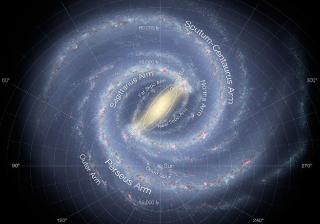Bibcode
Chrobáková, Ž.; López-Corredoira, M.; Sylos Labini, F.; Wang, H. -F.; Nagy, R.
Bibliographical reference
Astronomy and Astrophysics
Advertised on:
10
2020
Journal
Citations
20
Refereed citations
19
Description
Context. Recent statistical deconvolution methods have produced extended kinematical maps in a range of heliocentric distances that are a factor of two to three larger than those analysed in Gaia Collaboration (2018, A&A, 616, A11) based on the same data.
Aims: In this paper, we use such maps to derive the rotation curve both in the Galactic plane and in off-plane regions and to analyse the density distribution.
Methods: By assuming stationary equilibrium and axisymmetry, we used the Jeans equation to derive the rotation curve. Then we fit it with density models that include both dark matter and predictions of the MOND (Modified Newtonian dynamics) theory. Since the Milky Way exhibits deviations from axisymmetry and equilibrium, we also considered corrections to the Jeans equation. To compute such corrections, we ran N-body experiments of mock disk galaxies where the departure from equilibrium becomes larger as a function of the distance from the centre.
Results: The rotation curve in the outer disk of the Milky Way that is constructed with the Jeans equation exhibits very low dependence on R and z and it is well-fitted both by dark matter halo and MOND models. The application of the Jeans equation for deriving the rotation curve, in the case of the systems that deviate from equilibrium and axisymmetry, introduces systematic errors that grow as a function of the amplitude of the average radial velocity. In the case of the Milky Way, we can observe that the amplitude of the radial velocity reaches ∼10% that of the azimuthal one at R ≈ 20 kpc. Based on this condition, using the rotation curve obtained from the Jeans equation to calculate the mass may overestimate its measurement.
Aims: In this paper, we use such maps to derive the rotation curve both in the Galactic plane and in off-plane regions and to analyse the density distribution.
Methods: By assuming stationary equilibrium and axisymmetry, we used the Jeans equation to derive the rotation curve. Then we fit it with density models that include both dark matter and predictions of the MOND (Modified Newtonian dynamics) theory. Since the Milky Way exhibits deviations from axisymmetry and equilibrium, we also considered corrections to the Jeans equation. To compute such corrections, we ran N-body experiments of mock disk galaxies where the departure from equilibrium becomes larger as a function of the distance from the centre.
Results: The rotation curve in the outer disk of the Milky Way that is constructed with the Jeans equation exhibits very low dependence on R and z and it is well-fitted both by dark matter halo and MOND models. The application of the Jeans equation for deriving the rotation curve, in the case of the systems that deviate from equilibrium and axisymmetry, introduces systematic errors that grow as a function of the amplitude of the average radial velocity. In the case of the Milky Way, we can observe that the amplitude of the radial velocity reaches ∼10% that of the azimuthal one at R ≈ 20 kpc. Based on this condition, using the rotation curve obtained from the Jeans equation to calculate the mass may overestimate its measurement.
Related projects

Morphology and dynamics of the Milky Way
This project consists of two parts, each differentiated but both complementary: morphology and dynamics. Detailed study of the morphology of the Milky Way pretends to provide a data base for the stellar distribution in the most remote and heavily obscured regions of our Galaxy, through the development of semiempirical models based on the
Martín
López Corredoira